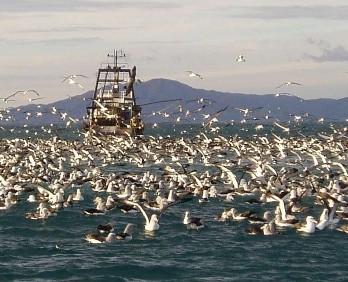Counts of seabirds around fishing vessels, collected by New Zealand Government fisheries observers, suitable for studies of seabird distribution.

Seabirds following a fishing trawler, Kaikoura, New Zealand.
New Zealand is a global centre of seabird diversity, with over 80 species breeding either on the mainland or on offshore islands. Seabirds are caught during both commercial and recreational fishing, and for some species these fatalities may threaten the viability of the populations.
Little is known about the distribution of seabirds in New Zealand waters. However, regular counts by government fisheries observers of the numbers of seabirds around fishing vessels may allow a greater understanding of the interactions between seabirds and fishing vessels. This in turn will help in the management of fishing to reduce seabird bycatch.
Two types of counts have been carried out. One programme aims at standardising the counts to maximise their comparability, and these counts have been recorded on paper forms. Another programme was developed, aiming predominantly at the survey of marine mammals in inshore fisheries, with the data being recorded on Nomad electronic devices. Due to different protocols, the two datasets are kept separate. The birds are identified as accurately as possible; however, observers' experiences and skills vary, and collecting seabird count data is not their primary task. Because of this variability, and because of the inherent difficulty in accurately counting birds behind fishing vessels, the data should be used cautiously. For further information, a report is available, describing the datasets and their limitations.
The collection of data is coordinated by the Department of Conservation, and processed by Dragonfly Data Science.


